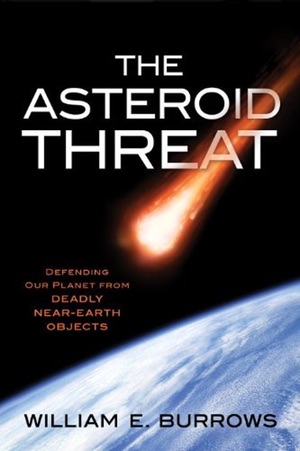Review: The Asteroid Threatby Jeff Foust
|
| He argues that NASA should make “planetary defense” a priority, establishing a Department of Planetary Defense within the agency staffed not just by agency personnel but also those from the military. |
However, it’s been less than two years since the meteor explosion over the Russian city of Chelyabinsk provided a startling reminder of the threats these objects can pose. There’s been some action in response to that incident: NASA has increased the funding for its Near Earth Objects Program and announced last year the “Asteroid Grand Challenge,” with the goal of finding all asteroids that pose a threat to humanity and know what to do to counter those threats.
That’s not enough for people like William E. Burrows, an author best known in space circles for well-regarded histories of the Space Age like Deep Black, Exploring Space, and This New Ocean. He starts off his latest book, The Asteroid Threat, by recounting the Chelyabinsk meteor. From there, he reviews what we know about the population of near Earth objects (NEOs) that could pose a threat to Earth and what could be done to deflect one. There’s also an entertaining aside where he examines how asteroid and comet impacts have been portrayed in books and film, from Lucifer’s Hammer and Deep Impact to lesser-known—and perhaps best-forgotten—made-for-TV movies.
Burrows is not just an uninvolved historian or journalist. Several years ago, he served on a committee established by the National Research Council to review how to detect and, potentially, deflect NEOs. That committee’s final report, published in early 2010, concluded that NASA’s budget at the time of $4 million per year for NEO searches was insufficient to meet a Congressionally-mandated goal of finding all NEOs at least 140 meters in diameter by 2020.
As one of the few non-scientists, and the only historian or journalist, on the committee, Burrows could presumably offer a unique perspective on the committee’s work, and its conclusions, in this book. Yet, oddly, he only mentions the committee’s work briefly in a few places in the book, and without any behind-the-scenes discussions of the committee and its deliberations. In fact, he only makes clear that he was a member of the committee in the acknowledgements section at the end of the book.
Burrows does have some ideas of his own about how to better conduct the search for, and defense from, NEOs. In one chapter, after an extended discussion of NASA’s history, he argues that the agency should make “planetary defense” a priority, establishing a Department of Planetary Defense within the agency staffed not just by agency personnel but also those from the military. Planetary defense, he argues, could be the “major mission” that NASA has lacked since the end of Apollo and the “near closure” of robotic exploration of the solar system (a closure that may come as a surprise for those actively involved in such missions today.)
Burrows doesn’t suggest how much should be spent on such a Department of Planetary Defense, but other passages in the book suggest that his research on the topic in general has holes. “Then, in 2005,” he writes in one chapter, “Congressman George E. Brown of California, whose constituents included several aerospace companies, led a campaign that expanded the number of potentially threatening intruders the space agency had to locate and catalog to 90 percent of those that measured 140 meters or larger by 2020.” While Congress did indeed include such language in a NASA authorization act approved that year, Rep. Brown did not lead that 2005 campaign: he passed away in 1999. (That section of the act was called the “George E. Brown, Jr. Near-Earth Object Survey” in his memory, which may be the source of his confusion.)
| It’s worthwhile to make the modest investment to keep watching the skies, but not to panic about them. |
The next sentence of that same paragraph begins, “But the Obama administration did not ask for funds to complete the task.” Of course, the Obama Administration wasn’t in a position to ask for funds in 2005, since the current president did not take office until January 2009. The current administration has, in fact, asked for additional money, increasing the funding for the Near Earth Object Program Office at NASA from $4 million in fiscal year 2009 to $40 million in 2014, an increase tied in part to the agency’s Asteroid Redirect Mission plans. (A recent report by NASA’s Office of Inspector General states that, even with that increased funding, NASA won’t meet the 2020 goal in the law, and that the program in general needs improved structure and oversight.)
There’s no doubt that NEOs do pose a hazard to the planet, as demonstrated by everything from the geologic record to the still-fresh memories of Chelyabinsk. However, Burrows doesn’t make the case in The Asteroid Threat that this risk is so severe that it requires a massive reorganization of NASA to counter it. Increased funding for ground-based searches, perhaps augmented by space-based observatories, like JPL’s NEOCam or the B612 Foundation’s Sentinel proposals, can help fill out the population of NEOs and identify which, if any, pose a threat for the foreseeable future. Such activities have the additional benefit of improving asteroid science and even finding targets for human exploration and resource extraction, work not mentioned in the book. It’s worthwhile to make the modest investment to keep watching the skies, but not to panic about them.
\